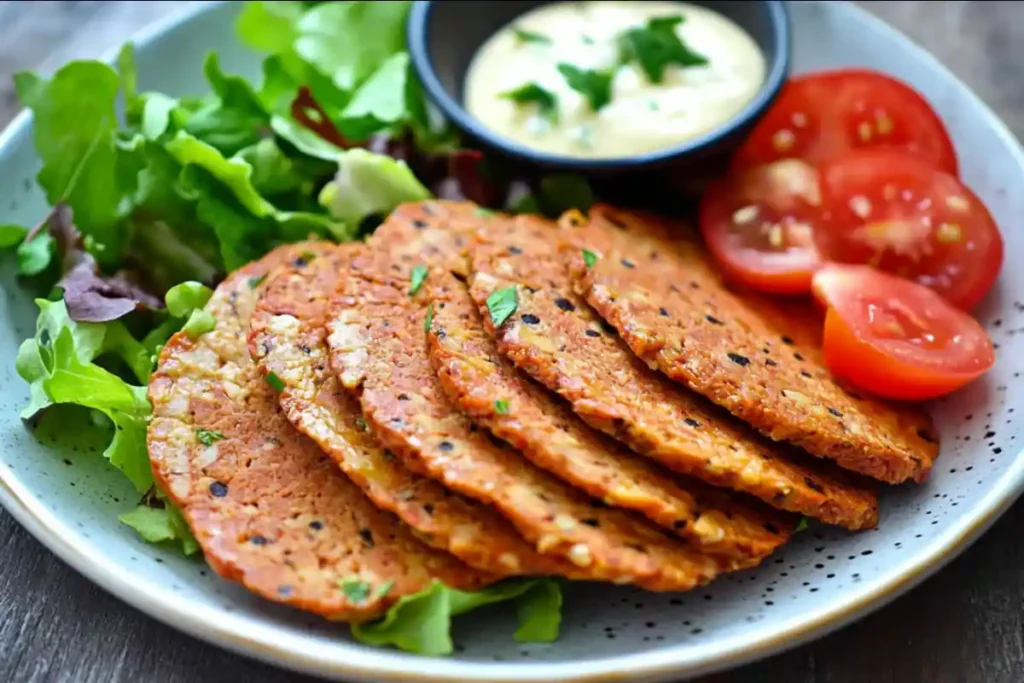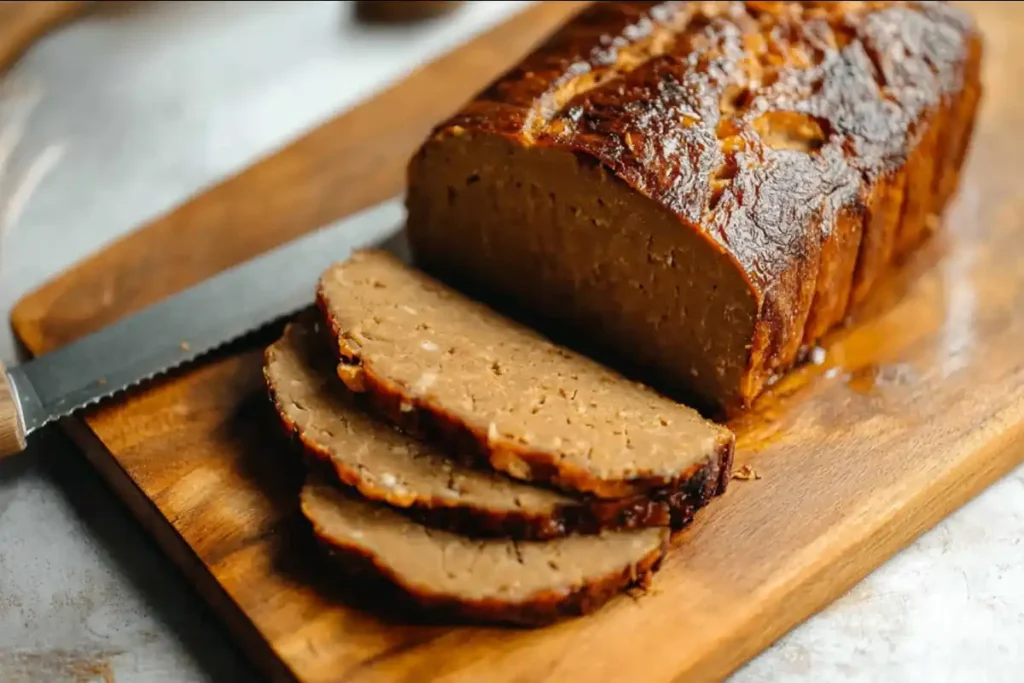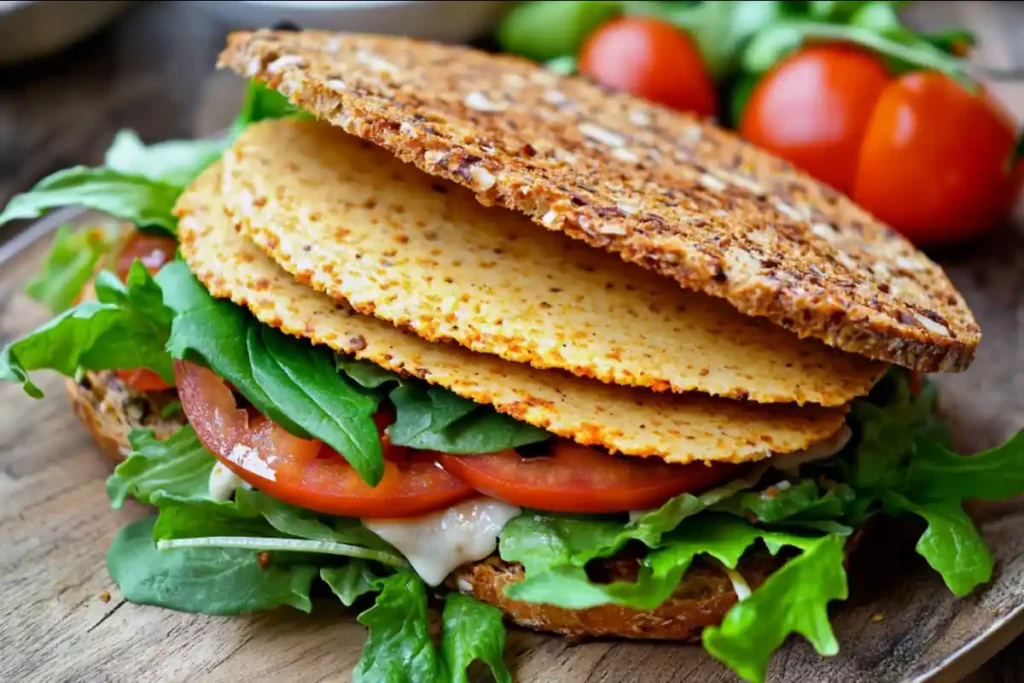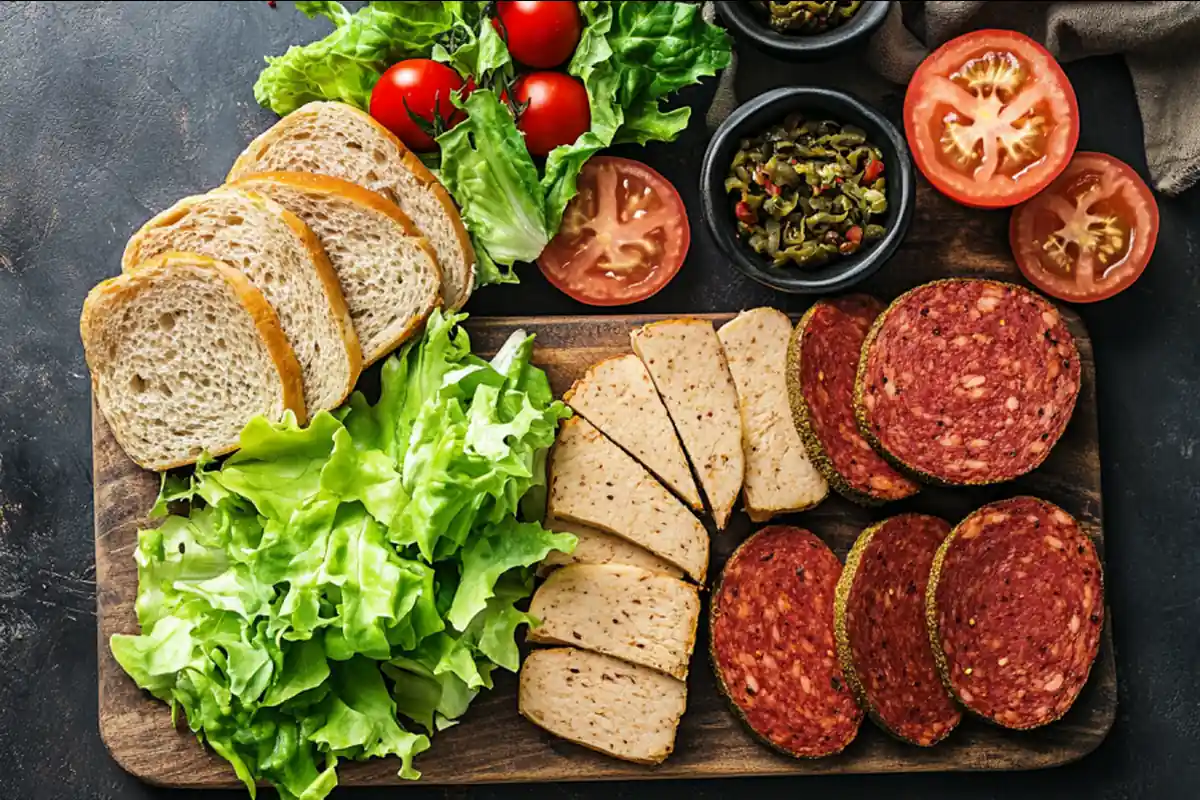What is vegan lunch meat made of? Discover key ingredients, production methods, health benefits, and a simple recipe to try at home.
Introduction
In recent years, more and more people in the United States have become interested in plant-based alternatives to traditional animal products. Therefore, vegan lunch meat has soared in popularity among those who want to reduce or eliminate meat consumption. However, you might still wonder: What is vegan lunch meat made of? This comprehensive guide will explore the ingredients and production methods, plus offer a detailed recipe and FAQs, so you can enjoy a delicious, healthy, and sustainable lunch.
Vegan lunch meat, also referred to as plant-based deli slices or vegan deli meat, is not just for strict vegans. In fact, it’s appealing to anyone looking for new tastes or healthier protein sources. Above all, plant-based lunch meats are proof that you can embrace a tasty and convenient lifestyle without giving up flavor or familiar textures. In addition, many modern brands have perfected the art of making these products look and taste very similar to conventional deli slices.
Below, we will explore each aspect in detail, focusing on how these meatless slices are created, their nutritional benefits, and how to select or prepare them. By the end, you’ll have a thorough understanding of vegan lunch meat—plus a recipe to try in your own kitchen.
- Introduction
- The Rise of Plant-Based Deli Slices
- Understanding the Ingredients in Vegan Lunch Meat
- The Nutritional Profile of Vegan Deli Meat
- How Vegan Lunch Meat Is Made
- Types of Vegan Deli Slices
- Tips for Selecting and Serving Vegan Lunch Meat
- Homemade Vegan Lunch Meat Recipe
- Are There Any Drawbacks?
- Conclusion
- Frequently Asked Questions
The Rise of Plant-Based Deli Slices

From Niche to Mainstream
In the past, vegetarian or vegan options were often hidden in small sections of grocery stores. However, plant-based products have moved into the spotlight. Many major U.S. retailers now carry a diverse range of vegan lunch meats to meet growing consumer interest. In addition, numerous fast-food chains and sandwich shops are adding vegan alternatives to their menus.
Despite humble beginnings, plant-based deli slices have come a long way. Initially, they were typically made from basic soy proteins with limited seasoning. Today, advanced recipes and technological innovations allow manufacturers to replicate tastes like roasted turkey, savory ham, or even spicy pepperoni—minus the animal products.
Why the Sudden Popularity?
Many factors have contributed to the surge in vegan lunch meat consumption. First, environmental awareness is rising, with more consumers wanting to lower their carbon footprint. Second, health considerations drive people to reduce their intake of processed meats, high cholesterol, and saturated fats. Furthermore, animal welfare concerns encourage consumers to look for cruelty-free options.
It’s clear that, as a result of evolving demands, the market for plant-based deli slices will keep expanding. In fact, global sales figures show impressive growth each year, indicating that vegan lunch meat is not just a fad but a lasting shift in consumer preferences.
Understanding the Ingredients in Vegan Lunch Meat
Key Plant Proteins
Soy Protein: Among the most common bases in vegan lunch meat is soy protein isolate or tofu. Soy-based slices have a notable protein content, and they provide a firm yet springy texture many people love. Moreover, soy is a complete protein, meaning it contains all nine essential amino acids.
Wheat Gluten (Seitan): Another popular choice is seitan, made from vital wheat gluten. It has a dense and chewy texture, which resembles the mouthfeel of traditional meat. In addition, seitan can be flavored in countless ways, lending itself well to various deli-style profiles.
Pea Protein & Legumes: Pea protein is gradually gaining traction as a soy-free alternative. When manufacturers combine it with other legumes like fava beans or lentils, the result is a meatlike texture that’s both satisfying and nutritious. These options cater to individuals who are allergic to soy or avoiding gluten.
Binding Agents & Texturizers
To keep vegan lunch meat sliceable, companies rely on binders. For instance, vital wheat gluten not only helps with protein content but also works as a binding agent. Tapioca starch or cornstarch may be used to improve the final product’s firmness. In addition, gums like xanthan gum or guar gum ensure a uniform texture throughout.
Flavor Enhancers and Seasonings
Without flavor, even the best-textured vegan slices would taste bland. As a result, manufacturers employ a wide variety of seasonings such as garlic, onion, paprika, and black pepper. Liquid smoke or smoked paprika often recreates the distinctive smokiness found in certain deli meats. Furthermore, nutritional yeast adds a savory, cheese-like depth known as umami.
Color and Fat Sources
Beet juice, annatto, or other vegetable-based dyes help provide a rosy hue reminiscent of certain sliced meats. Meanwhile, small amounts of coconut oil or non-hydrogenated vegetable oil deliver moisture and mouthfeel. However, for those watching their fat intake, it’s useful to compare labels to find lower-fat versions or those made with minimal oil.
The Nutritional Profile of Vegan Deli Meat
Protein, Fat, and More
When asking, What is vegan lunch meat made of?, you can’t ignore nutrition. Plant-based deli slices often rival their animal-based counterparts in protein. For example, a single serving of seitan-based lunch meat can contain up to 12–15 grams of protein. In contrast, it’s usually low in saturated fat and completely free of dietary cholesterol.
Vitamins and Minerals
Many brands fortify their vegan lunch meats with iron, calcium, or vitamin B12, all crucial for a balanced vegan diet. In addition, some incorporate vegetable and grain blends to increase fiber. Therefore, it’s wise to review nutrition facts to make sure you select a product aligned with your dietary goals.
Potential Health Benefits
Studies often indicate that reducing or eliminating red and processed meats can positively impact your health. Therefore, switching to a vegan deli slice may support lower cholesterol levels and reduced heart disease risk. However, keep in mind that not all vegan options are automatically healthy. Some can be high in sodium or contain additives.
Mindful Consumption
To ensure a nutrient-dense diet, combine vegan lunch meat with whole grains, fresh vegetables, or other plant foods. For instance, layering slices on whole-grain bread alongside leafy greens, tomatoes, and avocado makes a balanced sandwich. Moreover, checking sodium content is vital for anyone watching their salt intake.
How Vegan Lunch Meat Is Made
Small-Scale (Homemade) Production
Homemade vegan lunch meat starts with combining the chosen protein—often vital wheat gluten—with seasonings, beans, or tofu. Next, you knead or blend the dough to incorporate all ingredients. The mixture is then usually wrapped in foil or a cheesecloth and steamed or baked until it reaches a firm consistency. Therefore, the result is both customizable and relatively straightforward to prepare.
Industrial Manufacturing
Commercial production often involves extrusion technology that shapes and cooks the plant proteins in a more precise manner. Large machinery mixes, texturizes, and flavors the protein base under controlled conditions. Consequently, the end product can maintain consistent taste and texture over massive batches. Finally, the loaf is sliced, packaged, and shipped to grocery stores.
Types of Vegan Deli Slices
H3: Turkey-Style, Ham-Style, and Beyond
Plant-based brands now offer a dizzying array of flavor profiles. Turkey-style slices mimic the mild, lightly seasoned taste of roast turkey, and ham-style deli slices incorporate smoky, salty flavors. For fans of spicy fare, pepperoni-style or “Mexican spiced” slices can add zing to sandwiches, wraps, or pizzas.
Texture Options
Some vegan lunch meats are softer or made with tofu. Others, especially seitan-based products, tend to be firmer. As a result, texture preferences vary widely. You might prefer a softer, flakier bite, or you might enjoy the robust chew of wheat gluten-based slices.
Gluten-Free or Soy-Free Choices
In addition, the market is evolving to support gluten- and soy-free diets. Brown rice protein, pea protein, or other legume-based blends help create these specialty slices. If you have allergies or food sensitivities, it’s best to read labels carefully.
Tips for Selecting and Serving Vegan Lunch Meat
Reading the Label
When scanning grocery store shelves, check for terms like “non-GMO,” “organic,” or “fortified with B12.” Ingredients vary from brand to brand, so it’s crucial to read the label to see what exactly you’re buying. Moreover, you’ll want to note sodium, fat, and potential allergens such as soy, wheat, or nuts.
Sandwiches, Wraps, and More
Vegan lunch meats are extremely versatile. You can slip slices into a bagel sandwich or wrap them around crisp vegetables for a quick snack. Furthermore, they can be diced into pasta salads, layered on a charcuterie board, or simply grilled for a warm meal.
Looking for more plant-based midday inspiration? Check out our Vegan Lunch Ideas for creative wraps and hearty bowls. Also, if you’re curious about other vegan options, visit What Do Vegans Eat for Lunch? to explore additional recipes and tips.
Storage and Shelf Life
Typically, unopened vegan deli slices can last in the fridge for a week or two. Once opened, though, you should consume them within 3–5 days. To maintain freshness, reseal the package or store slices in an airtight container. Freezing is possible for many types, but always refer to the manufacturer’s guidelines.
Homemade Vegan Lunch Meat Recipe

If you want total control over ingredients and flavor, making your own vegan lunch meat at home can be a rewarding experience. Therefore, the following recipe uses seitan as the base to deliver a robust protein content and a hearty bite.
Ingredients
- 2 cups vital wheat gluten
- ¼ cup chickpea flour (or another legume flour)
- ¼ cup nutritional yeast
- 2 teaspoons smoked paprika
- 1 teaspoon garlic powder
- 1 teaspoon onion powder
- 1 teaspoon black pepper
- 1 teaspoon salt (adjust to taste)
- 1 teaspoon dried oregano
- 2 tablespoons tomato paste (for color and extra flavor)
- 1 tablespoon soy sauce (or tamari for gluten-free variation—ensure other ingredients are GF)
- 1 tablespoon olive oil (optional for moisture)
- 1 ½ cups vegetable broth (plus extra if needed)
Step-by-Step Cooking Instructions
- Combine the Dry Ingredients:
In a large mixing bowl, whisk together the vital wheat gluten, chickpea flour, nutritional yeast, smoked paprika, garlic powder, onion powder, black pepper, salt, and dried oregano. This ensures even distribution of flavor before adding liquids. - Mix the Wet Ingredients:
In a separate smaller bowl, stir together the tomato paste, soy sauce, olive oil, and vegetable broth. Make sure all components are well-blended. - Form the Dough:
Slowly pour the wet mixture into the dry ingredients. Use a spatula or spoon to combine. If the dough appears too dry, add an extra tablespoon or two of vegetable broth, but be careful not to make it soggy. - Knead the Dough:
Transfer the mixture onto a clean surface. Knead the dough for about 4–5 minutes, as kneading helps develop the gluten for a firmer, chewier texture. If the dough becomes too sticky, lightly flour your hands or the surface. - Shape and Wrap:
Shape the dough into a log or loaf. Then, wrap it tightly in foil, ensuring there are no gaps for steam to escape. Alternatively, you can use parchment paper and then foil to keep it from sticking. - Steam or Bake:
- Steaming Method: Place the wrapped loaf in a steamer basket over boiling water. Steam for approximately 60 minutes, turning it halfway through for even cooking.
- Baking Method: Preheat your oven to 350°F (175°C). Place the foil-wrapped loaf on a baking sheet and bake for about 60–70 minutes. Turn it over halfway through to help cook it evenly.
- Rest and Slice:
Once done, remove from the heat and let the loaf cool for 15–20 minutes. This resting period helps the slices hold together more effectively. Then, carefully unwrap the foil. - Slice and Store:
Slice the seitan loaf into thin deli-style pieces. Store in an airtight container in the fridge for up to 5 days or freeze for longer storage.
Nutritional Information (per 100g)
| Nutrient | Amount |
|---|---|
| Calories | 180 kcal |
| Protein | 24 g |
| Carbohydrates | 10 g |
| Fat | 3 g |
| Sodium | 360 mg |
| Fiber | 2 g |
| Iron | 2 mg |
(Values are approximate and can vary based on ingredient brands.)
Are There Any Drawbacks?
Processing and Additives
Although plant-based, certain vegan deli slices may still be highly processed. Some are laden with sodium, flavor enhancers, or preservatives to extend shelf life. Therefore, moderation and careful label reading remain essential.
Allergies or Sensitivities
Since a large number of vegan lunch meats use wheat and soy, these products are not suitable for individuals with allergies to those ingredients. Thankfully, the market offers alternatives that skip these allergens. Always, however, double-check packaging if you have any concerns.
Balancing Sodium
Processed foods, whether vegan or not, tend to contain more sodium. If you’re monitoring salt intake for health reasons, compare nutritional labels or consider a homemade recipe that lets you control the sodium level.
Conclusion
In conclusion, what is vegan lunch meat made of? It’s a flavorful combination of plant proteins, binding agents, seasonings, and often color enhancers that together create a product remarkably similar to traditional deli slices. As a result, you can craft a variety of sandwiches, wraps, and salads that seamlessly fit into a busy lifestyle or a creative culinary routine.
Moreover, these plant-based deli slices bring key benefits: they’re generally free of cholesterol, can be lower in saturated fat, and are often fortified with essential vitamins or minerals. However, it’s still wise to practice moderation and read labels carefully, especially for sodium content and additives.
Ultimately, whether you pick store-bought slices or embark on a homemade culinary adventure, vegan lunch meats make it easier than ever to reduce meat consumption without sacrificing taste. Therefore, give them a try, experiment with exciting flavors, and enjoy a healthier, more sustainable lunch routine.

Frequently Asked Questions
What is vegan deli meat made of?
Vegan deli meat is typically made from plant proteins such as soy, wheat gluten (seitan), or pea protein. Manufacturers then add binders, seasonings, and colorants to replicate the taste and texture of conventional deli slices.
Are vegan lunch meats healthy?
Generally, vegan lunch meats can be healthier than traditional processed deli meats due to zero cholesterol and often lower saturated fat. However, some brands may be high in sodium or include additives, so it’s crucial to read labels and consume them in moderation.
What is the main ingredient in vegan meat?
The main ingredient often depends on the brand, but soy or wheat gluten are the most common bases. Some products also use pea protein or blends of legumes and grains to achieve the desired texture and nutritional profile.
Is there any deli meat that is not processed?
Traditional deli meat is almost always processed to some degree, and the same is true for most vegan options. If you want to minimize processing, making homemade vegan lunch meat with simple ingredients at home is a great alternative.

